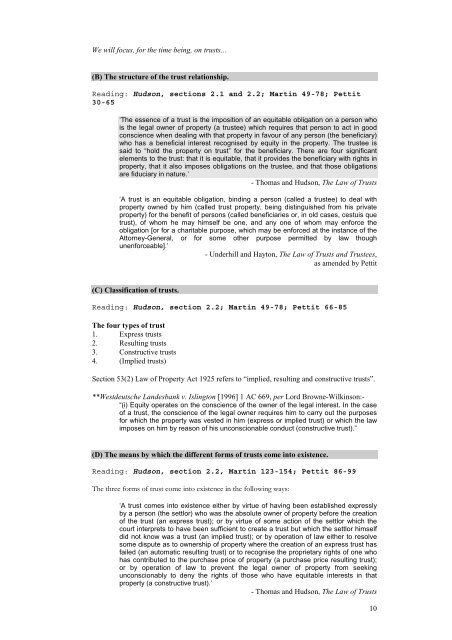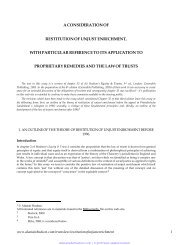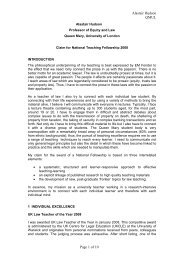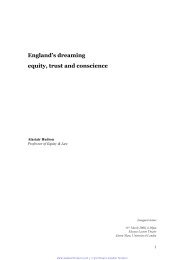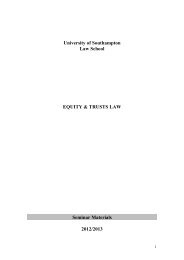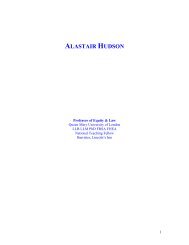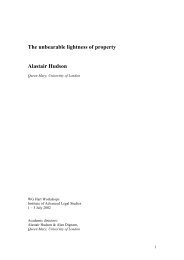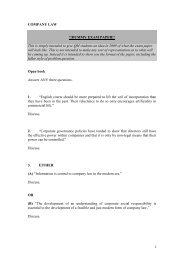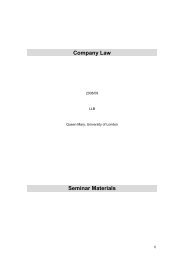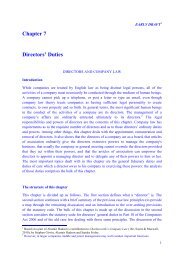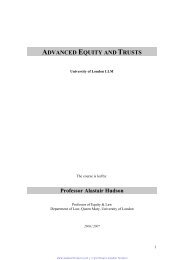Soton Equity and Trusts - alastairhudson.com
Soton Equity and Trusts - alastairhudson.com
Soton Equity and Trusts - alastairhudson.com
You also want an ePaper? Increase the reach of your titles
YUMPU automatically turns print PDFs into web optimized ePapers that Google loves.
We will focus, for the time being, on trusts…<br />
(B) The structure of the trust relationship.<br />
Reading: Hudson, sections 2.1 <strong>and</strong> 2.2; Martin 49-78; Pettit<br />
30-65<br />
‘The essence of a trust is the imposition of an equitable obligation on a person who<br />
is the legal owner of property (a trustee) which requires that person to act in good<br />
conscience when dealing with that property in favour of any person (the beneficiary)<br />
who has a beneficial interest recognised by equity in the property. The trustee is<br />
said to “hold the property on trust” for the beneficiary. There are four significant<br />
elements to the trust: that it is equitable, that it provides the beneficiary with rights in<br />
property, that it also imposes obligations on the trustee, <strong>and</strong> that those obligations<br />
are fiduciary in nature.’<br />
- Thomas <strong>and</strong> Hudson, The Law of <strong>Trusts</strong><br />
‘A trust is an equitable obligation, binding a person (called a trustee) to deal with<br />
property owned by him (called trust property, being distinguished from his private<br />
property) for the benefit of persons (called beneficiaries or, in old cases, cestuis que<br />
trust), of whom he may himself be one, <strong>and</strong> any one of whom may enforce the<br />
obligation [or for a charitable purpose, which may be enforced at the instance of the<br />
Attorney-General, or for some other purpose permitted by law though<br />
unenforceable].’<br />
- Underhill <strong>and</strong> Hayton, The Law of <strong>Trusts</strong> <strong>and</strong> Trustees,<br />
as amended by Pettit<br />
(C) Classification of trusts.<br />
Reading: Hudson, section 2.2; Martin 49-78; Pettit 66-85<br />
The four types of trust<br />
1. Express trusts<br />
2. Resulting trusts<br />
3. Constructive trusts<br />
4. (Implied trusts)<br />
Section 53(2) Law of Property Act 1925 refers to “implied, resulting <strong>and</strong> constructive trusts”.<br />
**Westdeutsche L<strong>and</strong>esbank v. Islington [1996] 1 AC 669, per Lord Browne-Wilkinson:-<br />
“(i) <strong>Equity</strong> operates on the conscience of the owner of the legal interest. In the case<br />
of a trust, the conscience of the legal owner requires him to carry out the purposes<br />
for which the property was vested in him (express or implied trust) or which the law<br />
imposes on him by reason of his unconscionable conduct (constructive trust).”<br />
(D) The means by which the different forms of trusts <strong>com</strong>e into existence.<br />
Reading: Hudson, section 2.2, Martin 123-154; Pettit 86-99<br />
The three forms of trust <strong>com</strong>e into existence in the following ways:<br />
‘A trust <strong>com</strong>es into existence either by virtue of having been established expressly<br />
by a person (the settlor) who was the absolute owner of property before the creation<br />
of the trust (an express trust); or by virtue of some action of the settlor which the<br />
court interprets to have been sufficient to create a trust but which the settlor himself<br />
did not know was a trust (an implied trust); or by operation of law either to resolve<br />
some dispute as to ownership of property where the creation of an express trust has<br />
failed (an automatic resulting trust) or to recognise the proprietary rights of one who<br />
has contributed to the purchase price of property (a purchase price resulting trust);<br />
or by operation of law to prevent the legal owner of property from seeking<br />
unconscionably to deny the rights of those who have equitable interests in that<br />
property (a constructive trust).’<br />
- Thomas <strong>and</strong> Hudson, The Law of <strong>Trusts</strong><br />
10


